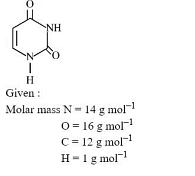Nucleotides are joined together by:
Nucleotides are joined together by:
Show Hint
- Glycosidic linkage
- Peptide linkage
- Hydrogen bonding
- Phosphodiester linkage
The Correct Option is D
Solution and Explanation
To solve the problem, we need to determine how nucleotides are joined together in a biological context.
1. Understanding Nucleotides:
Nucleotides are the building blocks of nucleic acids, such as DNA and RNA. Each nucleotide consists of a sugar molecule, a phosphate group, and a nitrogenous base.
2. Identifying the Bond:
In nucleic acids, nucleotides are linked to form a polynucleotide chain. The bond that joins nucleotides is formed between the phosphate group of one nucleotide and the sugar (specifically, the 3’ hydroxyl group) of the adjacent nucleotide. This bond is called a phosphodiester bond, which creates the sugar-phosphate backbone of DNA or RNA.
3. Confirming the Specificity:
The phosphodiester bond is specific to the covalent linkage between nucleotides in nucleic acids. Other types of bonds (e.g., hydrogen bonds) are involved in base pairing between strands, but the question focuses on joining nucleotides within a single strand.
Final Answer:
Nucleotides are joined together by phosphodiester bonds.
Top Questions on Nucleic Acids
- Two nucleotides are joined together by a linkage known as:
- JEE Main - 2024
- Chemistry
- Nucleic Acids
- Given below are two statements:
I. Cytosine and guanine are formed in equal quantities in DNA hydrolysis.
II. Adenine and uracil are formed in equal quantities in RNA hydrolysis. The correct answer is:- AP EAPCET - 2024
- Chemistry
- Nucleic Acids
- Assertion (A): Uracil base is present in DNA. Reason (R): DNA undergoes self-replication.
- CBSE CLASS XII - 2024
- Chemistry
- Nucleic Acids
- Identify the polarity from ‘X’ to ‘Y’ in the mRNA segment shown. Mention how many more amino acids can be added to the polypeptide that is being translated and why.
- CBSE CLASS XII - 2024
- Biology
- Nucleic Acids
- Uracil is a base present in RNA with the following structure $\%$ of $N$ in uracil is ___

- JEE Main - 2023
- Chemistry
- Nucleic Acids
Questions Asked in CBSE CLASS XII exam
- If $M$ and $N$ are square matrices of order 3 such that $\det(M) = m$ and $MN = mI$, then $\det(N)$ is equal to :
A battery of emf \( E \) and internal resistance \( r \) is connected to a rheostat. When a current of 2A is drawn from the battery, the potential difference across the rheostat is 5V. The potential difference becomes 4V when a current of 4A is drawn from the battery. Calculate the value of \( E \) and \( r \).
- CBSE CLASS XII - 2025
- Current electricity
If \(\begin{vmatrix} 2x & 3 \\ x & -8 \\ \end{vmatrix} = 0\), then the value of \(x\) is:
- Nita, Vidur and Mita were partners in a firm sharing profits and losses in the ratio of 3 : 4 : 1. On 1st April 2024, they decided to admit Samir as a new partner. The new profit sharing ratio between Nita, Vidur, Mita and Samir will now be 1 : 1 : 1 : 1. The balance sheet of Nita, Vidur and Mita before Samir’s admission showed machinery at ₹ 6,00,000. On the date of admission, it was found that the machinery is overvalued by 20%. The value of machinery shown in the new Balance Sheet after Samir’s admission will be :
- CBSE CLASS XII - 2025
- Admission of a Partner
Rupal, Shanu and Trisha were partners in a firm sharing profits and losses in the ratio of 4:3:1. Their Balance Sheet as at 31st March, 2024 was as follows:

(i) Trisha's share of profit was entirely taken by Shanu.
(ii) Fixed assets were found to be undervalued by Rs 2,40,000.
(iii) Stock was revalued at Rs 2,00,000.
(iv) Goodwill of the firm was valued at Rs 8,00,000 on Trisha's retirement.
(v) The total capital of the new firm was fixed at Rs 16,00,000 which was adjusted according to the new profit sharing ratio of the partners. For this necessary cash was paid off or brought in by the partners as the case may be.
Prepare Revaluation Account and Partners' Capital Accounts.- CBSE CLASS XII - 2025
- Partnership Accounts